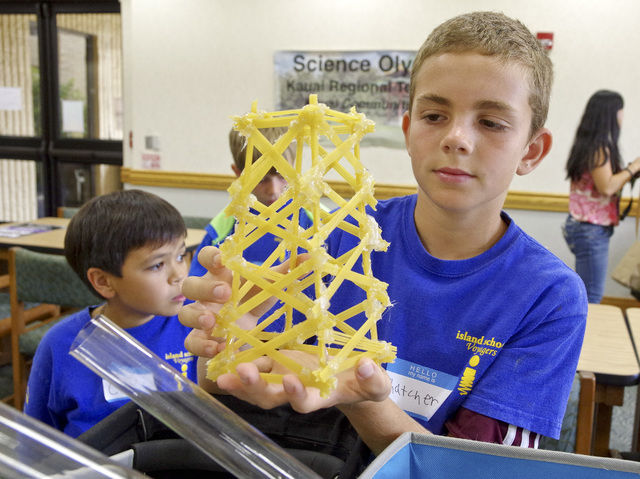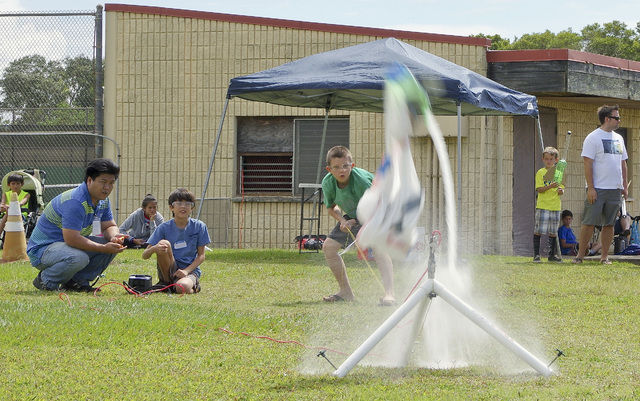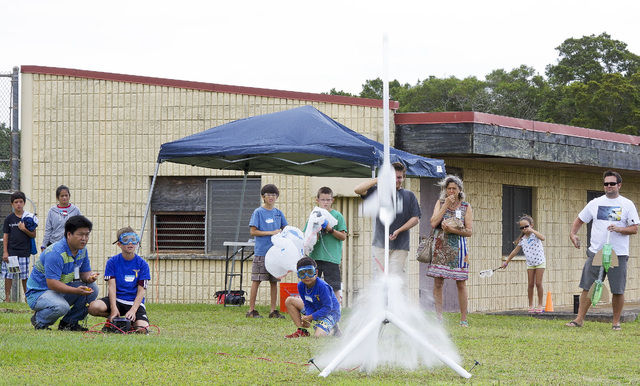PUHI — Thatcher Magoun and Connor Tavares sought answers before the pending launch of their bottle rocket Saturday during the inaugural Hawaii State Science Olympiad for elementary school students at Kauai Community College. After checking in with Bryson Toyofuku and
PUHI — Thatcher Magoun and Connor Tavares sought answers before the pending launch of their bottle rocket Saturday during the inaugural Hawaii State Science Olympiad for elementary school students at Kauai Community College.
After checking in with Bryson Toyofuku and Kim Strong of the HSSO, the pair from the Island School team discovered they could have used a recovery system for their rocket, provided the recovery system met the criteria for safety.
“What to do?” Magoun’s mind raced for answers while Tavares watched quietly. “A recovery system? That could add to the hang time which was the goal for the rocket — how long could it stay afloat after being launched?”
Cristy Peeren, the Island School coach, alleviated the young boys’ stress, explaining they followed the criteria for middle and high school, which did not allow for a recovery system.
Island School was one of five teams entered in the first time the HSSO was offered to elementary school students. It was joined by the Ahupua‘a Explorations with Meryl Abrams as coach; Cathleen Triplett of St. Catherine School coaching two teams; and Andra Drake coaching the team from St. Theresa Catholic School.
The “3,2,1, Blast Off!” phase involves science application and technology where teams create two rockets from 2-liter bottles which are pressurized with air and water.
“We experimented a lot,” Magoun said. “We tried different lengths of body. We tried three fins and four fins — three fins work the best. Our best time was 7.5 seconds after launch.”
Those results bore fruit as the team’s rockets tickled the seven-second mark, the first one (with a longer fuselage) hanging for 6.9 seconds and the second one coming close to that mark.
Liam Hall and Kala‘e Abrams, working as two friends as Explorers (as opposed to Ahupua‘a Explorations) were heartened by the Island School dilemma as they fielded a rocket which had trash bags attached to its rocket.
The hope was dashed as the liftoff resulted in a separation of the drag material and rocket resulting in a hang time of three seconds.
“Thatcher really likes science,” said Peeren, who got help from Sue Macklin and Erin Cobb-Adams. “These kids have been hard at work for weeks — just to get to this.”
During the Ramp-n-Roll event, Kai Spindt got help from Tavares after his partner fell ill on competition day. The event had teams design, build and test a gravity-powered vehicle released from a ramp, to travel 7 meters, and stop as close as possible to the end mark.
“Ours went past the 7-meter mark,” Tavares said. “We used a wing nut system where the wheels, when turned in one direction, stores energy, and when the wheels turn in the opposite direction, the energy is released. We had two tries, and both times, we went past the mark.”
Another project which kept the boys on edge was the Pasta Tower where teams had to design and build the lightest pasta tower with the highest structural efficiency, capable of supporting a load of up to 10 kilograms.
“We made lots of towers,” Magoun said. “We tested and found triangles to be the strongest. Our tower has lots of crosses, and when we weighed it, we could add more hot glue. The idea is to create the lightest and strongest.”
Some of the other challenges facing the teams included Experimental Design where teams’ ability were tested in designing, conducting and reporting findings of an experiment on-site; and the Gunk Challenge, in which teams designed a piece of material called “gunk” from three specific materials in order to meet criteria announced at the event.




